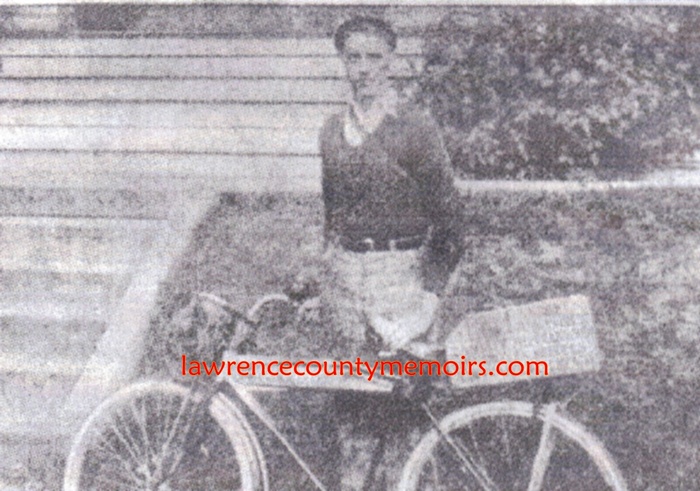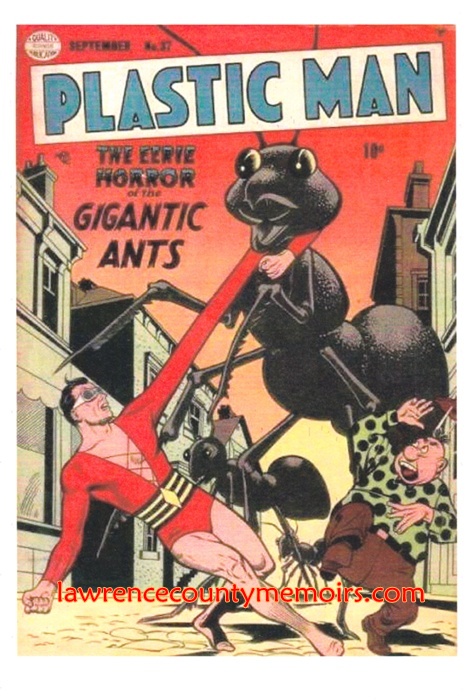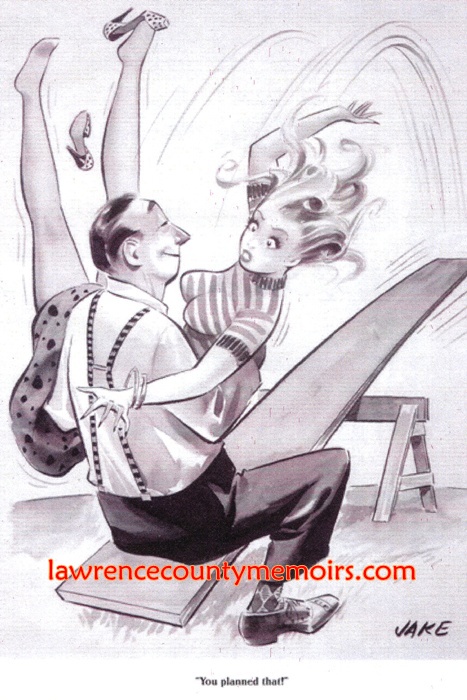Jack Ralph Cole was born in New Castle, Pennsylvania, on December 16, 1914. He was one of five children born to Delace and Cora Belle (Cooper) Cole of Euclid Avenue. During his lifetime Delace Cole (1882-1968) was associated with the W. J. Offutt Dry Goods and the New Castle Dry Goods stores and later owned his own insurance firm. He was also a popular figure in community affairs and a charter member (and future President) of the New Castle Rotary Club when it was established in 1919. Jack Cole, a gospel singer and extremely gifted artist, attended the local schools and graduated from New Castle High School in June 1932. It was the height of the Great Depression and times were hard.
Not long after graduating from high school he embarked alone on an ambitious cross country bicycle trip with a plan to witness the Summer Olympic Games in Los Angeles, California. His three-month journey was featured in several magazines and made him somewhat of a sensation in New Castle. Back home he found employment with the American Can Company in Mahoningtown, although he yearned to find work as an artist. He eloped with his sweetheart Dorothy “Dot” Mahoney, as they were secretly married in nearby New Brighton in July 1934. The newlyweds’ secret was soon out and they took up residence with her parents on Highland Avenue.
Within a few years the couple soon borrowed some money and relocated to New York City. Cole sought regular employment as an artist, but survived by selling the occasional light-hearted “gag cartoon” – a one-panel illustration with a humorous caption – to national magazines such as Boy’s Life and Collier’s. A while later Cole also began using the pseudonym of “Jake” while drawing risqué gag cartoons, featuring voluptuous femme fatales, for various men’s erotica digests. He seemed to have a particular affinity for the latter type of adult art.
It took some doing but sometime by early 1938 he was hired as an illustrator and writer for noted comic book publisher Harry A. Chesler. Cole quickly made a name for himself illustrating and writing story lines for various comic books for Chesler. Many of Cole’s early works were rife with dark, twisted, and disturbing themes that soon became all the rage in mainstream comics. In late 1940 the up-and-coming Cole was hired on by Lev Gleason Publications, one of the most popular comic book publishers during the 1940’s. He worked extensively on the Silver Streak Comics line and helped successfully revamp the popular Daredevil character (not affiliated with the Marvel Comics superhero of the same name) created by Jack Binder.
Cole soon took his considerable talents over to Quality Comics, a company that is known as a major player in the so-called Golden Age of Comics – from the late 1930’s to the early 1950’s. Cole was one of a handful of skilled artists employed by the company. Cole often assisted famed artist Will Eisner on his weekly syndicated cartoon that featured a masked crime fighter known as The Spirit. Cole’s biggest success came in the summer of 1941 when he created the enduring character known as Plastic Man. Plastic Man initially made guest appearances in various established comic books until he was given his own featured comic book in 1943. Cole thrived during the booming comic book industry of the 1940’s and was every bit as talented as famous contemporaries Will Eisner and Jack Kirby.
By the late 1940’s his comic book work slowed as he began to concentrate on drawing erotic gag cartoons. In the early 1950’s the comic book industry, under fire for its heroic portrayal of violence and lack of morals, began facing a major economic downturn. Cole’s last comic was published in early 1954 and he left Quality Comics after over thirteen years of employment. He fielded several offers from comic book companies and soon decided to move on to a new genre.
He began submitting his erotic gag cartoons to a bold new men’s magazine called Playboy. The inaugural issue of Playboy, featuring Marilyn Monroe on the cover, had been released in December 1953 and was soon on its way to being a major commercial success. Cole, at the urging of Playboy’s Chicago-based publisher Hugh Hefner, soon moved out to Illinois to work fulltime on the magazine. Cole’s stylish cartoons, usually featuring older men with young well-endowed females, were an immediate hit and he was soon the chief illustrator for Hefner. Cole’s cartoons soon became a regular feature in every single issue of Playboy.
Cole also realized a long-standing dream when he sold a daily syndicated cartoon strip to the Chicago Sun-Times in early 1958. The cartoon, entitled Betsy and Me, featured a young suburban couple dealing with family life and was completely different than his work at Playboy. The quirky comic strip began running in newspapers across the country in May 1958.
His run as a successful illustrator and writer came to a sudden and puzzling end a few months later. On the late afternoon of Wednesday, August 13, 1958, during a seemingly normal day, Cole drove to a sporting goods store and unexpectedly purchased a .22-caliber rifle. He drove on and pulled off on a gravel road near Woodside, Illinois, where he shot himself in the head. He was soon found by three boys and the police were summoned. Cole was rushed to a nearby hospital but passed away soon after arrival. Two separate suicide notes, written to his wife and to Hugh Hefner, were discovered. The reasoning behind his suicide was never publicly revealed and his wife, who was later remarried, remained tight-lipped about any personal struggles or demons he was facing. At only forty-three years old he was at the height of his career.
Cole’s remains were sent home to New Castle where a memorial service was held at the John H. Hodge Funeral Home on Saturday, August 16. He was subsequently laid to rest in Graceland Cemetery. Cole is fondly remembered as one of the most famous comic book illustrators of all time and his mysterious death continues to baffle many people to this day.
 Jack Ralph Cole, the son of a prominent businessman and civic leader, was born in New Castle in 1914. He was a gifted student and involved in the choir of his church. Not long after graduating from New Castle High School in June 1932 he embarked on a three-month-long bike trip to California. The trip made him a minor celebrity in his hometown. Upon his return he found work in a local factory but yearned to be a successful artist. (1932) Full Size |










Comments
Harry Banks #
My family was next door neighbors to the Cole family in the late 20s. I knew Jack Cole when I was a kid and seen the bike he rode to Los Angles & back to New Castle. It was a Shelby made in Shelby Ohio. My brother was a dealer & sold many of them. I still have there catalog & pictures of every bike they made. It was a very sad ending for Jack Cole. Harry L Banks
Paul Tumey #
Hi. I’m the writer and historian who created the Cole’s Comics website which has 225 articles on Cole and his work. I’m glad to to see Jack Cole being remembered and especially excited to read the comment from Harry Banks. Mr. Banks — any chance I could ask you a few questions via email or on the phone about Jack Cole? I am writing his biography and your memories would be invaluable. My email address is: paultumey@gmail.com
Thanks!
Terri Miller #
I’ve been a Plastic Man fan since I was a young child in the 1980’s.
I just got back into this amazing & nostalgic superhero.
So sad to hear of his creator.
Hope Plastic Man gets a movie made!
Comment